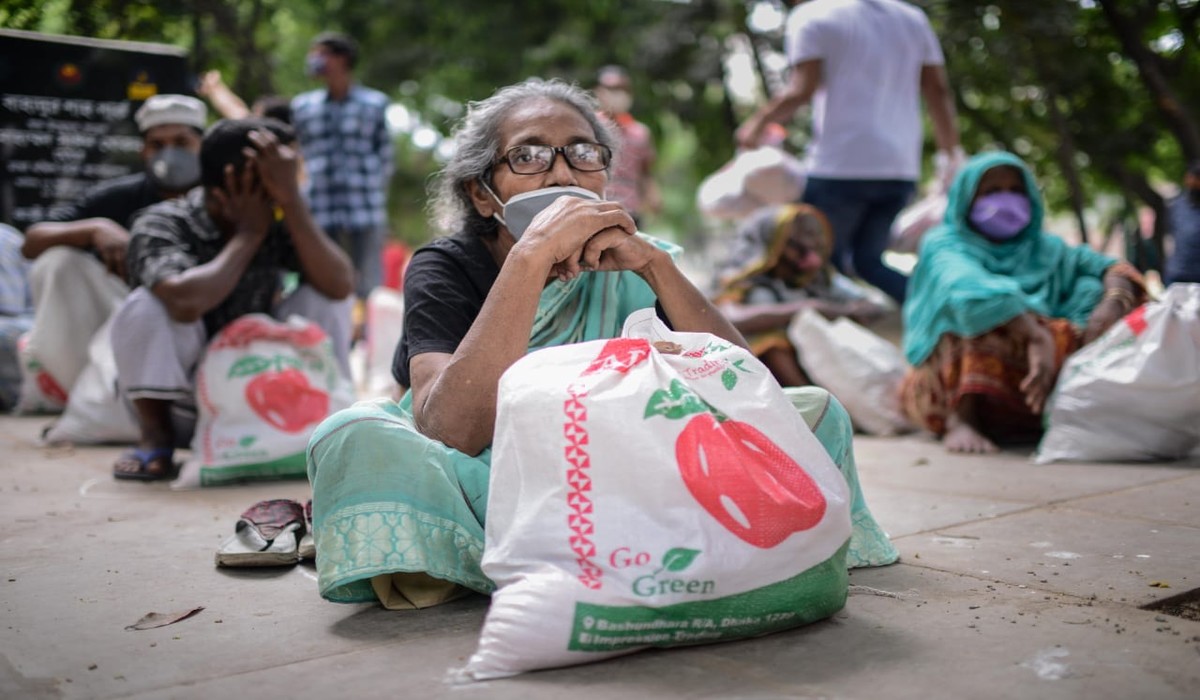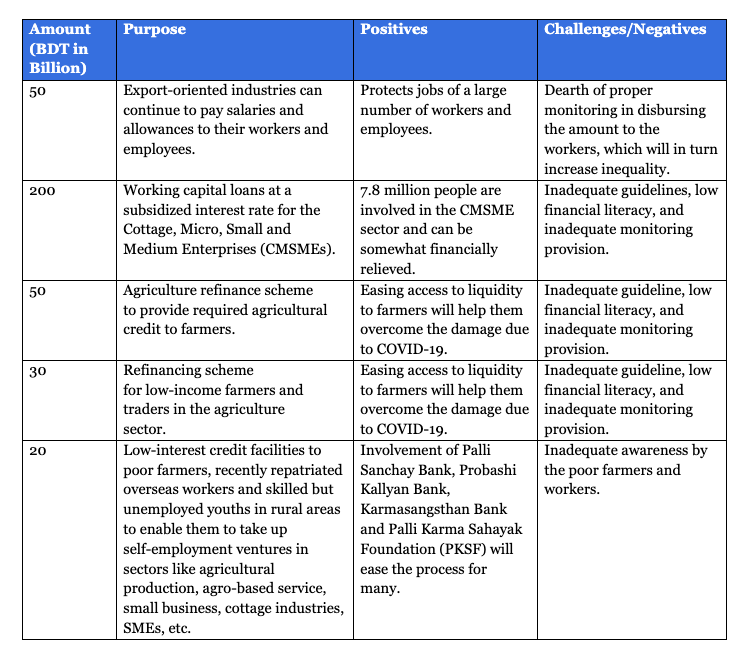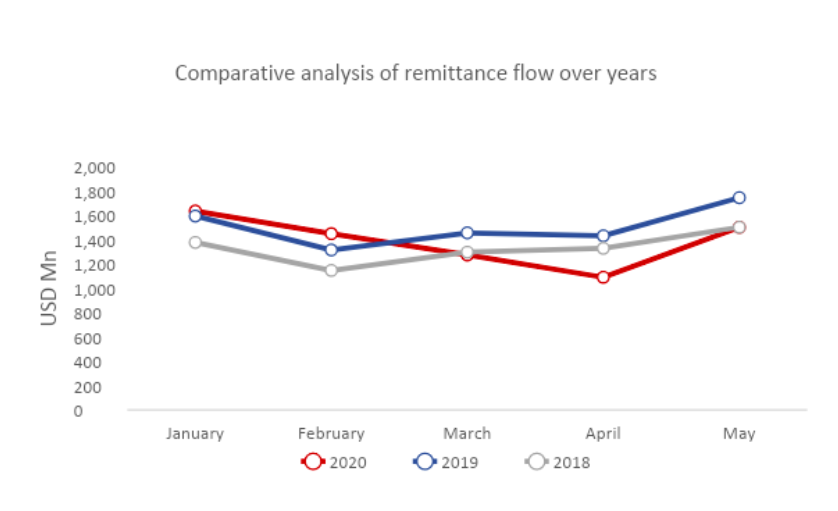GET IN TOUCH
- Please wait...

COVID-19 has obstructed Bangladesh’s longstanding streak of economic growth. In the last decade, the robust economic growth rate of 6% to 7% facilitated Bangladesh’s battle against poverty, leading to a decrease in poverty rates to 20.5% (2019) from 33.4% (2009) and extreme poverty rates from 19.3% (2019) to 10.5% (2009). [1][2]
However, the achievement may be at stake, and according to predictions by South Asian Network on Economic Modeling (SANEM), a local think tank, poverty rate has doubled to 40.9% due to the pandemic, and the resulting ‘general holidays’.
Public health damages and the economic downturn, triggered by the pandemic, have inflicted a negative 25% income shock to at-risk groups. [3]
Among the four main targets of the budget, the third one is to expand the coverage of the government’s social safety net programs to protect the extreme poor and low-paid workers of the informal sector from the sudden loss of livelihood due to the recent events. [2]
While the target is well-intentioned, the pragmatism and the scope of the labor market initiatives and social safety net programs are questionable.
The Government has announced multiple stimulus packages for preventing mass layoffs from targeted sectors. The BDT 50 billion stimulus package for export-oriented industries may be helpful in temporarily protecting the jobs of the 3.5 million RMG workers.
Likewise, the BDT 200 billion CMSME stimulus package, if disbursed properly, might salvage the jobs of 7.9 million SME workers. The refinance schemes and low-interest credit facilities will be pertinent to the Agriculture sector, which ensures the livelihood of 41% of the population.

Inward remittances have played a key role in alleviating poverty and maintaining Bangladesh’s foreign exchange reserves. In 2019, 12 million Bangladeshi migrant workers sent USD 18.33 billion in remittance, making the sector the second-highest source of foreign currency. [4]
[5] Due to the onslaught of COVID-19 pandemic, inward remittance started to fall in February and hit the lowest in the last 3 years in April (USD 1.09 billion). Most Bangladeshi migrant workers are stationed in the gulf (56%), South East Asia (14%), and Italy (5%).
During the pandemic and resulting lockdowns in host countries, many Bangladeshi migrant workers experience job losses or furloughs. As a result, inward remittance plunged during February to April and finally started to rebound in May (USD 15 billion) when workers started to re-join the workforce.

The national budget 20-21 has allocated BDT 641 Crore or BDT 6.41 billion (USD 75 million) for the Ministry of Expatriates’ Welfare and Overseas Employment. An additional BDT 50 billion or 5000 crore BDT (USD 58.63 million) was allocated as soft loans for the returnees through Probashi Kalyan Bank.
Although there is an 8% increase in allocation from last year, it may not be enough, considering the contribution of the remittances to the economy.
Given the importance of need to maintain stable employment levels to raise revenue for the budget, the targeting of sectors such as international labor, Agriculture, CMSME, RMG, etc., is a step in the right direction. To yield success, however, efficient application and disbursement of the stimulus packages are pertinent.
Some stimulus packages, like the CMSME stimulus, requires exhaustive documentation for applications. Low-income and marginalized communities, such as rural based SMEs, often lack the paperwork and skills to avail the benefits of the packages. In addition to low-interest credit facilities, returnee remittance workers may also require robust capacity building programs to adjust in the local job market.
The imposition of the lockdown to curb transmissions of infection will cripple the income and livelihood of millions. To avert this situation, the government has taken an initiative to disburse direct cash transfers to 5 million people in the current fiscal year.
All poor senior citizens in 100 upazilas, who are most prone to poverty due to the coronavirus outbreak, will be brought under the Old Age Allowance as per the existing policy and receive monthly stipends of BDT 500. [6] This will add 500,000 new beneficiaries, and an additional allocation of BDT 3 billion will be provided to this program. [2]
Likewise, all widows and women deserted by their husbands in 100 upazilas who have been badly affected by pandemic and the lockdown, will be provided with monthly stipends of 500 BDT under a separate allowance program. [7] This will add 350,00 new beneficiaries, and an additional allocation of BDT 2.1 billion will be provided to this program.
Although the steps taken by the government are appreciable, they may not be enough to combat the dramatic increase in poverty rates. Prior to COVID-19, the number of people below the poverty line was 32 million in Bangladesh, and due to COVID-19 it has soared up to 64 million.
The addition of up to 850,000 new beneficiaries under the allowance programs for senior citizens and marginalized women will be making a small dent in the pandemic-triggered poverty. It must also be noted hat there is no comprehensive database to help facilitate the distribution of allowance to widows and women who have been deserted by their husbands.
As part of the strategy to eradicate rural poverty, an allocation of BDT 1 billion was proposed in FY20-21 budget for the ‘Rural Social Services Programme’ to keep the rural economy moving in the aftermath of the COVID-19 pandemic. As with other programs, the amount allocated may not be enough, given that 64% of Bangladesh’s population resides in rural areas. [8]
The government has also allocated BDT 955.74 billion in the social security sector, which is 16.83% of total budget and 3.01% of GDP in FY20-21. However, no systematic solutions were talked about to help the economically vulnerable people hampered by COVID-19. [2]
The national budget of FY20-21 should have been more focused on social protection, poverty alleviation programs, and programs for CMSMEs to overcome the turmoil in short-term (Post-COVID) year 1.
Unfortunately, only 5.6% has been allocated to social safety and welfare with lack of clear directions about monitoring the efficiency of the allocations. [2] More than 50 million workers in Bangladesh are involved in the informal sector, and their livelihood is simply at stake. [9]
The Asian Development Bank (ADB) has also predicted that a total of six months of the outbreak can cause 900,000 job losses in Bangladesh. [10] The hardship of these groups should have been addressed in the budget but was somewhat overlooked.
It is imperative that revisions of the announced budget consider the sufficiency of the allocations to the affected groups and sectors. Revisions should also include well-delineated instructions about the applications of allocations. Otherwise, the pandemic, and the consequent economic downturn, may severely harm Bangladesh’s hard-earned gains in poverty reduction.
Author: Farah Hamud Khan, Senior Business Consultant and Nahian Hasnin, Business Analyst, LightCastle Partners Ltd.
As part of LightCastle’s budget analysis, we look into the direct and indirect impacts of this year’s budget on different sectors. While some of the sectors have received significant policy assistance, others have been cast aside in the government’s attempt to salvage additional revenues for financing the budget. The economic contribution and perceived importance of the sector were key considerations while deciding whether the sector will be eligible for policy support. In this write-up, we look into the immediate term impacts of the budget on the Economically Vulnerable People.
Our experts can help you solve your unique challenges
Stay up-to-date with our Thought Leadership and Insights